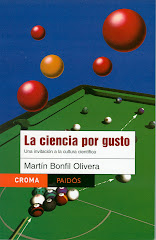by Martín Bonfil Olivera
Published on Milenio Diario, April 29, 2009
 The problem is that's what viruses are like: promiscuous and addicted to gambling. And that's what evolution is like, taking species trough twisted and unexpected roads. And that's what science is like, unable to advance on its own road, no less random, faster than it can, held up by its method, which demands it makes sure about what it knows up to that moment before taking the next step.
The problem is that's what viruses are like: promiscuous and addicted to gambling. And that's what evolution is like, taking species trough twisted and unexpected roads. And that's what science is like, unable to advance on its own road, no less random, faster than it can, held up by its method, which demands it makes sure about what it knows up to that moment before taking the next step.
The influenza virus which is currently bothering us (family orthomyxoviridae, type A, the most common ones, that also infect birds, pigs and horses) is, as are all viruses, a protein capsule that contains genetic material; in this case, ribonucleic acid (RNA), the older and less stable cousin of DNA.That's part of the problem: RNA copying is less accurate: sometimes it adds, sometimes it substracts, and thus causes spontaneous mutations inside one species of viruses.
And if several different viruses infect one same cell, they can recombine, taking with them pieces of genetic information from the others. The virus that concerns us has genes from other influenza viruses that infect humans, pigs and birds. And it can continue changing. What's alarming is the fact that it has learned to jump from human to human (as was feared from bird flue in 2006).
Its last name H1N1 refers to two proteins of its surface: haemaglutinin (of which there are 15 variants; this is number 1), which the virus uses to bind to the cell it's going to infect, and neuraminidase (9 variants) which allow the new viral particles to come out of the infected cell without being stuck to it.
Oseltamivir (Tamiflu -do not self medicate!), one of the drugs that work against the current influenza virus, inhibits this enzyme, and prevents that the new viruses form disseminating.
Science, as evolution, is unpredictable. I can seem slow and expensive, but if James Watson and Francis Crick hadn’t discovered, 56 years ago, the DNA double helix, today we wouldn't have the molecular biology tools that allow us to study and fight this virus.
And if we do not widely invest in scientific investigation —as Barack Obama said, immediately backing his words by increasing his country's investing in science by 3 percent of USA's gross domestic product— we won't be able to fight future crises -whether they be health crises or any other type of crises.
(translated by Adrián Robles Benavides) To receive Science for pleasure weekly
in your email, subscribe here!




No comments:
Post a Comment